The Caged Bird: The Story of T.A. Thompson

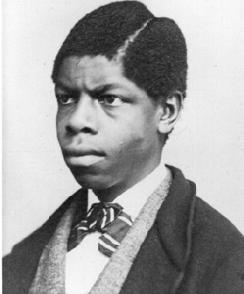
Theophilus Thompson
There are many mysteries in chess history, blank spots that have remained unfilled. One of the largest is the life of Theophilus Augustus Thompson, the talented American problemist of African decent. Jeremy Gaige’s Chess Personalia, the leading source of biographical data on chessists, only provides a single entry for Thompson’s birth, and nothing for his death. Why is this?, the reader wonders. Why is so little known about Thompson?
What little we know of Thompson’s life comes from a single publication, his book of chess problems printed in 1873 by Orestes Brownson Jr., the editor of the Dubuque Chess Journal. It is thanks to Brownson that we know “T. A. Thompson (colored) was born in Frederick City, Maryland, on the 21st day of April 1855.” We can add that Thompson’s parents were slaves; fortunately for Thompson, he saw the end of slavery as a young man, and witnessed its death throes in his own state.
Maryland, like its neighbor Virginia, was a crossroads of the American Civil War, and numerous skirmishes took place on Maryland soil. Also, while technically loyal to the Union, Maryland did allow slavery, and at times there was so much pro-slavery agitation that it seemed as if it was solely the Union army that held the state from secession. The young Thompson had plenty of opportunity to see an army, both rebel and Union, while he was growing up.
It was in Frederick that widow Barbara Fretchie allegedly waved the American flag from her attic window at Stonewall Jackson’s troops, an action made immortal by poet John Greenleaf Whitter. The flag-waving happened, if it happened at all, in 1863, when Jackson’s troops were en route to Gettysburg; Thompson was eight years old on that day when “Up from the meadows rich with corn, /Clear in the cool September morn, ” the rebel army came through. For his safety, Thompson probably was prevented from witnessing the spectacle of the blue-uniformed troops marching through town, although he probably knew what they meant for his race. It was in this charged atmosphere that Thompson grew up, amid the “clustered spires of Frederick” and the sounds of warfare.
Fortunately for both Thompson and America, the rebellion was quashed, and slavery ended. Unfortunately for both Thompson and America, the man who did the most to win his freedom, President Abraham Lincoln, would die at an assassin’s hand a week before Thompson’s tenth birthday. The bullet that took Lincoln’s life also helped chart the rocky course of relations between the Caucasian and Negroid races in the United States. What was termed “Reconstruction” of the South began. Buildings can be rebuilt, but minds are not so easy to reopen.
“Thompson’s thoughts on his discovery of chess are lost to us; we are also missing information regarding his possible knowledge of the existence of other Black chess players. Theophilus Thompson may have been the best-known Black chessplayer, but he was hardly the first. The Game of Kings was a favorite of a number of prominent free Blacks before the war, as reported in the abolitionist press.”
In 1868 Thompson started work, taking a job as a house servant in a home in nearby Carroll County, Maryland. But this proved to be short-lasting, and by 1870 the fifteen year old Thompson was back in Frederick. And it was in this city that Thompson was to have his meeting with J. K. Hanshew, the man who helped him become “possessed of the open sesame to Caïssa’s gardens of ever increasing intellectual delights”, as Brownson put it.
As Brownson wrote, Thompson “saw a chessboard and men used for the first time in April, 1872, when he witnessed a contest between Mr. S. of Ohio and Mr. H. of Frederick City. Although he could not understand the game and dared not ask questions for fear of annoying the players, he watched every move with the closest attention. The party finished, he went home, fully determined to learn the game. Mr. H. having heard of his ardent desire loaned him a chessboard and a set of chess men, gave him some instructions, and left him a few two-move problems to solve.”
Thompson’s thoughts on his discovery of chess are lost to us; we are also missing information regarding his possible knowledge of the existence of other Black chess players. Theophilus Thompson may have been the best-known Black chessplayer, but he was hardly the first. The Game of Kings was a favorite of a number of prominent free Blacks before the war, as reported in the abolitionist press.
Our knowledge of Black Americans who played the Royal Game comes from an essay on chess by James McCune Smith, a English-born Black doctor and prominent journalist. When Frederick Douglass was preparing the second of his three autobiographies, My Bondage and My Freedom, it was Smith he selected to write the Introduction. Although Smith’s heavily Victorian prose, grandly rhetorical and well-larded with classical allusions, has not worn well over time, Douglass made a good choice by asking Smith for an Introduction.
“Surely, thought we, chess is a question of magnetism; given, a fair parity in skill between two players, and the more powerfully magnetic will sway and conquer the will of the less magnetic, and force him into moves according to his will.”
In the abolitionist magazine the National Era for September 1859, Smith records his impressions of the First American Chess Congress, held in New York City two years previously. Amid his remarks on the tournament, on tournament winner Paul Morphy, Louis Paulsen, and chess in general, he included a brief account of his own indoctrination into the game. “Years ago, in the early months of our still persistent honeymoon, I purchased a pretty but fragile set of chessmen, and aided by an old copy of “Walker”, and the new frau, made some little progress in chess, until little fingers grew up round the table, and made a general smash of knights, pawns, and rooks, and little cares of another kind interfered with further proficiency. And it is good testimony in favor of the game, that when knight and pawn so went to the band, no harsh nor unkind word was uttered against their young destroyers, the chubby fingers were not rapped, nor their owners punished.
“My description of the game attracted some friends to buy board and book; and in a little while, Fylbel, the Downings, one of the Reasons, and an occasional jew-pedlar who insisted on taking the king, (the atrocious regicide!) with the preliminary exclamation, “chess de koenig” formed as clumsy a set of chess players as could be hunted up. The appearance of Staunton’s Chess-Players Hand Book was an era in our progress, although months were wasted in discussing the laws of the game by that born Causidicus, who now presides over the Sea-Girt House at Newport. In course of time, we became decent players….
“Surely, thought we, chess is a question of magnetism; given, a fair parity in skill between two players, and the more powerfully magnetic will sway and conquer the will of the less magnetic, and force him into moves according to his will. We had tried this often, directly, with the susceptible engraver, P. H. R., and once, in a reflex manner, with J. S., of Providence. In this latter instance, he being the less practiced player, but of impressible nerves, by fixing our attention on the board at the same moment with him, and marking out the best move against us, he invariably made that move, and won; per contra, while, in another game, we made moves, and then looked away; ignored the board until he had moved; unmagnetized, the termination of the game was speedily against him.”
Earlier in his essay Smith had implied that Paul Morphy himself was at least partially Black, the doctor commenting on Morphy’s “fine, open countenance, brunette hue, marvelous delicacy of fibre, bright, clear eyes, and elongated submaxillary bone…” While this can be considered just another example of the human tendency to make our heroes in our own image, it does underline Smith’s desire to see a Black chessplayer enter the top rank of amateurs.
Hiding behind Smith’s causal descriptions of his opponents are some prominent names in the abolitionist movement. “One of the Reasons” refers to either Charles Reason, the first Black mathematician, and first Black to hold a teaching position at an ‘White’ college, or one of his relations. Smith also played against George T. Downing, a Black hotelier and businessman of Newport, Rhode Island. While no gamescores between these men survive, Smith did leave brief pen-sketches of their play.
Of George Downing’s game, Smith wrote that he “makes the most vigorous attacks of any of them, but, after the twelfth or sixteenth move, his attention is exhausted, and some careless move makes him an easy prey to a less vigorous opponent. In his case, this failure in attention, or continuity, is confined to his chess play; in business, or in public movements, in which he is deeply interested, he is constant, persistent, and steadfast as a sleuth bound. This would seem to indicate that his perceptive faculties are deficient, or are easily wearied over the chess-board.”
Unfortunately not all of Smith’s references to Black chessplayers can be readily traced. A number of others hide behind initials, an admirable attempt to preserve their privacy, but frustrating to the historian. “Another amateur, W. C. I., is a most interesting study at the chess-board. He has fine perceptive faculties, is a splendid boxer, of quick, strong, combative temperament, and of full physical imagination. He makes the most beautiful combinations we ever saw on the chess – board; they seem as brilliant as fireworks; but he loses almost every game, not from breaking down of his continuity or attention, so much as from an incurably mercurial disposition, which leads him to forsake a sound move for one apparently more brilliant, but less safe. This gentleman bought a mare the other day, which, in twenty four hours, kicked three wagons to pieces, and threw him out each time; of course, instead of getting rid of her, he is “bound” to break her, it will be “such a splendid feat.” From the nature of the faculties which it calls into play, we regard chess as a physical as well as intellectual exercise, requiring muscular work as well as brain work.”
Another missing “among these friends” of Smith, is, “P. H. R., the engraver … the only one who plays an even, unflagging game throughout; indeed, as many have found to their chagrin, [he] plays the better end game, the worse his chances appear to be. His perceptive faculties are trained by his employment, and rather improve than weary by continuity of exercise.”
Earlier in his essay Smith had implied that Paul Morphy himself was at least partially Black, the doctor commenting on Morphy’s “fine, open countenance, brunette hue, marvelous delicacy of fibre, bright, clear eyes, and elongated submaxillary bone…” While this can be considered just another example of the human tendency to make our heroes in our own image, it does underline Smith’s desire to see a Black chessplayer enter the top rank of amateurs. Smith planted a seed of hope in his essay by mentioning in passing “the negro prodigy recently announced in Alabama.” This “prodigy” never materialized, and Smith’s dream of a prominent Black chessist remained unfulfilled, deferred.
Eventually, when Hanshew started his magazine Maryland Chess Review, he included Thompson’s games and problems, treating T. A. Thompson as well in the magazine’s pages as he treated his other contributors.
James McCune Smith died in 1865; had he lived an additional eight years, he may have seen his dream come true in Frederick, Maryland. He never got to judge the “perceptive faculties” of Theophilus Thompson. But in 1872, a White man favorably judged this same sense of perception in Thompson, and as stated, educated the young man with knowledge of the game. This man, “Mr. H” of the biographical sketch, was John K. Hanshew, chess problemist, magazine editor, and correspondence player.
Hanshew was in a good position to judge Thompson’s chess progress, since Thompson was a domestic in the Hanshew household. The game Thompson saw that ignited Caissa’s spark in him was as likely as not played in the Hanshew drawing room.
The exact details of the relationship between Hanshew and Thompson may never be known, but it went far beyond that of merely master and servant. Hanshew was a man who ignored the class and race prejudices of his era to teach chess. Blacks were considered by many to be a separate, lower order of man, and perhaps an entirely different species; whatever Hanshew’s private views on the subject, he spent a great deal of time and effort helping Thompson.
And its clear Thompson’s chessic debt to Hanshew was enormous. Aside from teaching the young man the moves and rules of the Royal Game, he also encouraged his budding interest in chess problem composition and introduced Thompson to correspondence play. Eventually, when Hanshew started his magazine Maryland Chess Review, he included Thompson’s games and problems, treating T. A. Thompson as well in the magazine’s pages as he treated his other contributors.
Hanshew also introduced the talented Thompson to Orestes A, Brownson Jr., the editor of the Dubuque Chess Journal. Brownson was the firstborn son of one of America’s leading Roman Catholic theologians, Orestes Brownson. In the obituary of the elder Brownson that appeared in the Catholic World of 1876, his namesake is described as “pass[ing] his life as a teacher and farmer in a remote State, living the life of a good Catholic with the spirit of a recluse, altogether uninterested in the affairs of the world.”
The younger Brownson may have been uninterested in worldly affairs, but he probably remembered his father’s many print and pulpit attacks on slavery and slaveholding, and so welcomed the budding problemist with open pages to his magazine. Brownson knew talent when he saw it; in less than a year, Brownson would be publishing a book of the young man’s problems. As he wrote in the book’s introduction, “Hearing last summer of the Dubuque Chess Journal, he soon be came a subscriber, a student, and a contributor. Hereto, accumulating the following rich store of chess compositions that are offered for perusal to the general chess reader with great pleasure and much confidence by the proprietors of the Dubuque Chess Journal.”
The book’s Frontispiece problem set forth Thompson’s talents and tastes in spectacular fashion with a mate or selfmate in four moves for either side.
.jpg)
1.Nxg4 Mate or self-mate in four for either color. 1-0
Chess Problems, Frontispiece.
Thompson would come to specialize in such problems. Although present-day problemists often scorn such many-move or trick problems, they were popular in the nineteenth century, and they remain popular today among some in the chess problem community. We present an example of such a work by Thompson, a rare problem in which Black moves first, also unintentionally containing a mate in three involving another piece.
.jpg)
Walter Korn, in America’s Chess Heritage, credits Thompson with the popularization of the term selfmate over the more pretentious sounding “sui-mate”. Thomspon had an strong interest in selfmates, and composed several of them. Here is one of his shorter ones:
.jpg)
Self-mate in three, 1-0
Brentano’s Chess Monthly, December 1881, p. 449
Thompson’s artistry was rewarded with praise from the small world of chess problemists and solvers. As the July 1874 issue of City of London Chess Magazine wrote of his book, “We have been very much pleased indeed with the composition in this book, and consider that they display real genius, both of a conceptive and constructive order. . . . We consider Mr. Thompson a composer of great merit and of rare promise.”
While problems are the best-known aspect of Thompson’s chess life, it wasn’t the only one, as stated above. Thompson also played chess both over the board and by correspondence. As part of the learning curve, J. K. Hanshew may have discussed his own postal and over the board games with his Black protégé. Although this game is flawed by White’s blunder in the early middlegame, this encounter with Charles H. Blood of Biddeford, Maine, does illustrate Hanshew’s interest in current opening theory. It’s a good example of the model of chess play that Thompson would follow.
Correspondence, 1874 |
|---|
1.e4 e5 2.Nf3 Nf6 3.Nxe5 d6! 4.Nf3 Nxe4 5.d4! d5 5…Bg4; 5…Be7 might also be played here. We prefer the move in the text. 6.Bd3 Nc6 The German Handbuch considers this the best reply to White’s sixth move. 7.c4 7.Qe2 is preferable to the move in the text. White might also play; 7.0-0 7…f5 8.Qe2 Bb4+ 9.Bd2 Bxd2+ 10.Nbxd2 0-0
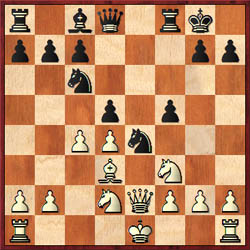
11.Ne5 White evidently overlooked the consequences of this move. This blunder cost him the game. 11…Nxd4 12.Qd1 Re8 13.0-0 White cannot save the Knight. 13…Rxe5 14.f4 Re8 The best square for the Rook. Black is now a piece and pawn ahead. 15.Nf3 Ne6 16.Qc1 d4 17.b3 N6c5 18.Ne5 Nxd3 19.Nxd3 Nc3 20.Kh1 b6 21.Ne5 Bb7 22.Qc2 Qh4 22…Be4 looks equally as good, if not better. 23.Qxf5 Ne2 24.Qf7+ Kh8 25.Qxc7 Ng3+ 26.Kg1 Nxf1 27.Rxf1 Be4 28.Nf7+ Kg8 29.Nd6 Re7 0-1 (see game)
Maryland Chess Review 1874, p. 212-213.
At this point in biographical sketches of Thompson its customary to print a postal miniature Thompson scored against the hapless Mr. Blood. In addition, we give you what possibly was the companion game to the well-known brilliancy. The postcards and letters coming from Frederick, Maryland, evidently were not very inspiring ones for Charles Blood.
Correspondence, 1874 |
|---|
1.e4 e5 2.Nf3 Nc6 3.d4 exd4 4.Nxd4 Qh4 5.Nb5 Qxe4+ 6.Be2 Kd8 7.0-0 a6 8.N1c3 Qe8 9.Nxc7 Kxc7 10.Nd5+ Kd8 11.Bf4 d6 12.Nb6 Ra7 13.Bxd6 Bxd6 14.Qxd6+ Bd7 15.Bg4 Nf6 16.Bxd7 Qe7 17.Qd3 Ne5
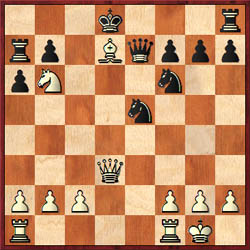
18.Qd4 Nexd7 19.Nxd7 Qxd7 20.Qxa7 Qc8 21.Qd4+ Qd7 22.Rad1 Qxd4 23.Rxd4+ Kc8 24.Re1 1-0 (see game)
Correspondence, 1874 |
|---|
1.e4 e5 2.Nf3 Nc6 3.Bc4 Bc5 4.b4 Bxb4 5.c3 Bc5 6.d4 exd4 7.cxd4 Bb6 8.0-0 d6 9.Nc3 We prefer 9.Re1 ; White might also play 9.d5 , the usual reply to which is 9…Na5 9…Nf6 10.Bb2 0-0 11.d5 Na5 12.Bd3 c5 13.h3 Re8 14.Re1 Bd7 15.e5 dxe5 16.Nxe5 c4 17.Nxc4 Nxc4 18.Bxc4
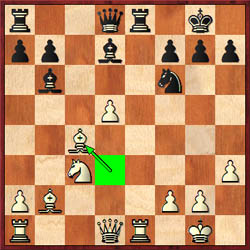
18…Bxf2+ 19.Kxf2 Qb6+ 20.Kf1 Qxb2 21.Qb3 Qd2 22.Ne2 b5 23.Bd3 Qg5 24.Rad1 Re3 25.Kg1 Bad, but White has no good move. 25…Bxh3 0-1 (see game)
Maryland Chess Review 1874, p. 168-169
In 1874 Hanshew announced a “postal card tournament” for subscribers to his Maryland Chess Review. Unfortunately the tournament outlived the magazine, which folded in 1875, and a final result table was never published. Thompson’s play, and his results, in what turned out to be his only chess tournament were erratic. It appears that in cases where he had a bad position, as against the eventual tournament winner William Shrinkman, he resigned early rather than play it out. Perhaps he was discouraged, perhaps he was overly respectful of his White opponents, or perhaps he was trying to save his energies and money for games in which he stood better. We include three of the games below. All the annotations are by J. K. Hanshew.
Maryland Chess Review Postal Card Tournament, 1875 |
|---|
1.e4 e5 2.Nf3 Nc6 3.Bc4 Bc5 4.b4 Bxb4 5.c3 Ba5 6.0-0 6.d4 and 7.O-O is generally played. The course adopted is Mason’s attack. 6…Nf6 The proper defense. 7.d4 0-0 8.Nxe5 Nxe4 Black might also play 8…Nxe5 9.dxe5 Nxe4 10.Qd5 Bxc3 11.Nxc3 Nxc3 12.Qf3 d5 etc. 9.Nxf7 Mason continued the attack by 9.Ba3 9…Rxf7 10.Bxf7+ Kxf7 11.d5 Ne5 Black would have fared badly by 11…Nxc3 , as the following will show: 12.Qh5+ Kg8 (If 12…g6 13.Qxh7+ etc.) 13.dxc6 etc. 12.Qd4 Bxc3 13.Nxc3 Nxc3
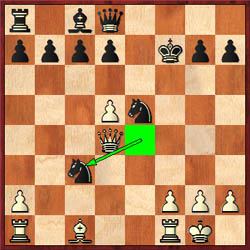
14.Qxc3 This seems the best Knight to take. 14…d6 15.Bb2 g5 Evidently played to prevent the advance of the f pawn; it fails, however, to answer the purpose. 16.f4 gxf4 17.Rxf4+ Kg8 18.Qg3+ Ng6 19.Rf6 Bf5 Why not resign before sacrificing this Bishop? 20.Rxf5 1-0 (see game)
Maryland Chess Review 1875, p. 215-216
Maryland Chess Review Postal Card Tournament, 1875 |
|---|
1.e4 e5 2.Nf3 Nc6 3.Bc4 Nf6 4.Ng5 d5 5.exd5 Na5 6.d3 h6 7.Nf3 e4 8.Ne5 Bd6 9.Bb5+ c6 10.dxc6 0-0 11.cxb7 Bxb7 12.Ng4 exd3 13.Bxd3 Re8+ 14.Be3 Nd5 15.Bb5 Re6
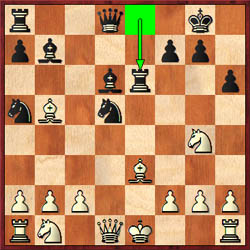
16.c4 Bb4+ 0-1 (see game)
Maryland Chess Review 1875, p. 420-421
Maryland Chess Review Postal Card Tournament, 1875 |
|---|
1.e4 e5 2.f4 exf4 3.Bc4 d5 4.Bxd5 Qh4+ 5.Kf1 g5 6.Nf3 In a game between J. H. Zuckertort vs Allies (see The Westminster Papers, January 1875), the former continued 6.Nc3 , followed by 7.Nb3, a course preferable to the one in the text. 6…Qh5 7.h4 h6 8.Bxf7+ First practically tried by Zuckertort in the game mentioned at move six. 8…Qxf7 Forced. If 8…Kxf7 White replies 9.Ne5+ winning Queen. 9.Ne5 Qg7 In our opinion f6 was a better square for the Queen. 10.Qh5+ Kd8 11.Nf7+ Ke7 Perhaps 11…Kd7 would have been better. 12.Nxh8 Nf6 13.Qg6 Qxh8 14.d3 Qg7
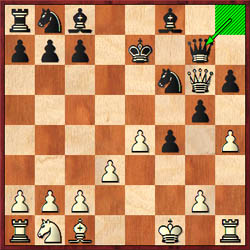
We fail to see the object of this move. 15.Qxg7+ 1-0 (see game)
Maryland Chess Review 1875, p. 280
Discussions of race, slavery, and the American Civil War are distressingly locked into a simplistic binary pattern that mocks human nature and human history. The American nation was never “half slave and half free”, even prior to the guns going off. There were Blacks who lived in freedom south of the Mason-Dixon line before the war, and the “free” North was hardly free for the man of color. Frederick Douglass wrote of what he called “republican Negro hate” in My Bondage and My Freedom, and many of his cited examples of racism came from the North. Likewise Theophilus Thompson was free; free from slavery, but also free to be discriminated against by people unable to see beyond his skin and their blinders.
And there seems little doubt that even in “freedom”, Thompson wore chains. Aside from Hanshew’s and Brownson’s magazines and his book publication, he was ignored by chess columnists and writers. No invitations for tournaments appeared, no games were published, and no notes describing Mr. Thompson’s chess activities were printed in columns. Occasionally a problem appeared in a chess column or magazine; that is all. Thompson’s mentor Hanshew closed down Maryland Chess Review in 1875, and he himself died a few years later, leaving Thompson without a job and without a promoter. One wonders if the Hanshews truly didn’t need a servant, or if they merely didn’t need a proud Black chessplayer as servant.
The pall of obscurity that fell over Thompson’s career after the publication of his book has hampered study of his life by historians. Even Jeremy Gaige in his massive Chess Personalia was unable to provide Thompson’s death date. Dr. Daaim Shabazz, in his essay on Thompson at The Chess Drum website, has reported an oral tradition that Thompson lived until 1910. This is consistent with the 1880 US Census, which shows Thompson employed as an oysterman in his native Maryland. The 1920 Census shows Thompson alive at age 64, with a wife and child, his public chess playing and composing days long behind him.
A comparison to another amateur chessplayer who flourished the same time as Thompson is instructive. Ellen Gilbert, the wife of a Hartford, Connecticut, builder, like Thompson was unable to get significant over the board practice. Like Thompson, she turned to correspondence chess. Unlike Thompson, Mrs. Gilbert was celebrated in chess columns across the United States and around the world. She was invited to compete in the International Postal Card Match of 1878, and defeated British master George H. D. Gossip in four games. Both Mrs. Gilbert and Mr. Thompson were gifted chessists, but Mrs. Gilbert was White and socially prominent in her city. Thompson was Black and a workingman, the child of slaves and slavery. Mrs. Gilbert had time, means, and society on her side; Thompson had to do without.
Typical of the sort of grudging acceptance the American chess world accorded Thompson is the following incident with one of America’s best-known chess columnists. Gustavus Reichhelm, chess editor of the Philadelphia Times, and himself a problemist of no mean ability, published in his column of November 19, 1882 a “pertly put” mate in three by the “colored chess champion”.
.jpg)
A few weeks later, Reichhelm was moved to present “an amusing anecdote” of Thompson to his readers: “During the visit of “T. Augustus” to this city, some years ago, he dropped in at the Mercantile Library Chess Room several times and played some games with a Mr. W. Not long after a friend and frequent adversary of Mr. W. asked one of the frequenters of the chess room to play a game with him, but he refused, declaring that he would not play with any white man who would so far forget himself as to play with a “nigger” and that, furthermore, he would not condescend to play with a white man who played with a white man who played with a “nigger”.
The last word in the Reichhelm quotation above has been considered a vulgarity and a slur among both Caucasians and Blacks for centuries, and even in today’s ‘liberated’ society the word is routinely euphemized as “the N word”. Reichhelm was an educated man, a music teacher by profession. He wrote his column for a major newspaper in a major American city. Reichhelm was a skilled chessplayer, having played two matches for the American championship. He himself was a respected problemist with a taste for the sort of “grotesques” that Thompson routinely composed. That Reichhelm could so glibly quote this disparagement of a fellow problem composer, and that the newspaper would print it, answers the question posed at the beginning of this essay. Why is so little known about Thompson? The answer is both easy and uncomfortable. He was Black. In his life he was shut out from chess, and now, as far as history knows him, he is an invisible man.
The poet Paul Laurence Dunbar wrote that he knew why the caged bird sings. We can only speculate why Thompson played chess, but it’s evident he too was a caged bird. Society kept him behind bars even as it removed his chains. His chess genius was forced into the forms of problems and correspondence play. In those forms he sang., just as he, and his struggle, sings today for those who will listen.
Solutions to Problems
Frontispiece:
Mates: White 1.Nxg4; Black 1…Rf1+
Selfmates: White 1.Qg8+; Black 1….Bb4+
Jumbo: 1…Rh8+ 2.Kg5 Rh5+ 3.Kf4 Rf5+ [3…Nd5#] 4.Ke3 Rf3+ 5.Kd4 Rd3+ 6.Kc5 Rd5+ 7.Kb4 Rd4+ 8.Ka3 Ra4+ 9.Kb2 Ra2+ 10.Kc1 Rxc2#
Mate in Three: 1.Bh8+
Copyright 2006 Neil R. Brennen (chessnews@mindspring.com). All Rights Reserved.
